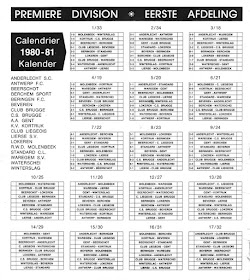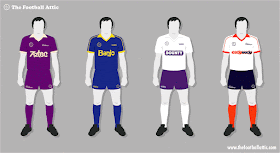In all my years as a Panini devotee, I’d only ever collected the Italian company’s UK stickers. I knew nothing of their annual ‘Football’ albums from across the channel, but when I did stumble upon them during an eBay visit one day, I soon realised they would be an unattainable fantasy. The eventual selling price for these European Panini albums was always well beyond my budget, and I had to accept that some things in life were just never meant to be.
Luckily for me, my luck changed a few weeks ago when I snapped up the Belgian version of Panini’s Football 81 album for a very reasonable price indeed. What I saw inside was an alternative take on the sticker collections of the early Eighties as I knew them with some subtle (but no less significant) variations.
To begin with, there was the inside front cover. In Panini’s UK albums, this was where you’d usually find a grid in which to write the First Division results for the current season. In the Belgian version, there was a series of small, individual score charts for each gameweek. They both fulfilled the same function, yet somehow the latter version looked more appealing.
After an introductory page featuring a two-piece team picture of the Belgian national team and a review of Belgium’s excellent Euro 80 campaign, the 18 clubs of the Belgian First Division were dealt with in the traditional manner. The double-page layout looks familiar, and yet it’s slightly neater than what we were used to seeing in the UK with 14 players, the manager, the club badge and a two-piece team picture all arranged with pleasing formality.
Look closer, however, and you’ll notice that the player stickers are all in Landscape format rather than the UK-favoured Portrait. Strange as it may seem, this allows for a square space in which the player can be seen, as well as a decent-size club badge, the club name and a rectangular symbol showing the club’s colours on the right. Contained within an outline box along containing the usual profile details, the overall look is smart, even if some of the profile text appears randomly above the sticker rather than below it.
So what else was different about this Belgian book of brilliance? Well, frankly, it was the novelty of everything being so.. non-British. For a start, every shirt worn by every player in every team had an enormous sponsor logo. Then there were the team badges - so unfamiliar to one used to seeing the famous crests of Arsenal, Everton or Manchester United. And then there were the players, many of whom mean nothing to the average British fan, yet a scant few shine out like diamonds. Close examination reveals Dutch master Arie Haan in the line-up for Anderlecht, Cloughie’s 'clown,' Jan Tomaszewski, in goal for Beerschot and his Polish team-mate Gregorz Lato in the white shirt of Lokeren.
Looking for familiar faces indeed becomes something of a preoccupation here as you turn each page. A star of the Belgian national team surfaces occasionally (Jean-Marie Pfaff for Beveren, Erwin Vandenbergh for Lierse) amid a welter of talent from Yugoslavia, the Netherlands, Poland, Denmark and beyond, yet I was also surprised to find a few lesser-known Brits as well.
Plying their trade in the land of beer and waffles, we find James Gillespie of Gent, a one-time Queens Park player and Scottish ‘amateur international’. Down in the Second Division, there was Ron Ferguson, once a young striker at Sheffield Wednesday and Darlington but now playing in Brussels where, over six seasons, he averaged a goal every four games. And at KV Mechelen there was Stan Brookes, a defender who spent six years at Doncaster before spending another six in the Belgian second tier. Overlooked in Britain, their reward for moving to Belgium was seeing their face on a Panini sticker - something that wouldn't have happened had they stayed in Blighty.
As mentioned earlier, the strangeness of seeing unfamiliar team badges on foil stickers was undeniable, but some of them are worthy of particular mention for their sheer peculiarity. Dip into the Tweede Afdeling (that’s the Second Division, to you and me) and you’ll find La Louviere represented by a sheep’s head emerging from a fur coat. No, wait a minute... it’s a wolf, apparently. Or how about Sporting Hasselt, who appear to have adopted someone’s rough sketch of two hands holding a football? One wonders whether Millwall missed a trick by not following Olympic and their iconography, but the top prize for surrealism surely goes to RC Harelbeke. Their badge showing a stylised football player with a rat’s head and tail shows just how far behind the UK was when it came to LSD-influenced logo design.
The final eleven pages of the album dedicated to the Second Division are arguably the best of all. They’re comprised of two sections, the first dedicated to the badges and team pictures of all 16 teams, the second showing off the players in a half-and-half style that Scottish fans of Panini will be all too familiar with.
Add those to the welter of odd-sounding foreign player names, Pony kits and team managers that look like they could form a police identity parade for someone arrested on a charge of indecent exposure and you have, in many ways, a Panini album that surpasses anything available in the UK 34 years ago.
True, I was curious to know what football in another country looked like while I was growing up, and I hoped this latest purchase of mine would finally tell me. All I can say is that Panini have rewarded me for my curiosity, just as they always did, by making a wonderful sticker album that delivered in every possible way. With colour, attention to detail and great efficiency, they were undoubtedly the masters of the football sticker world.
- Chris Oakley




















